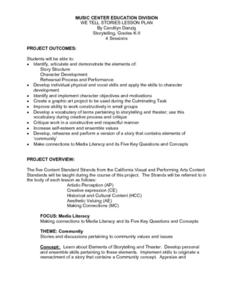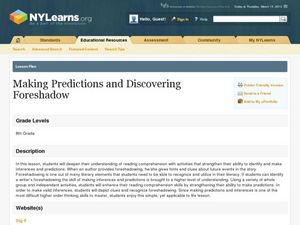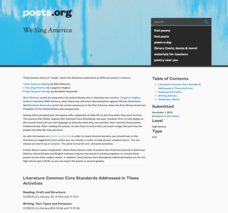Curated OER
We Tell Stories
Young readers bring characters to life by working in small groups to script and perform stories that contain a community concept. Detailed questions and activities are outlined for the class. Consider having your groups create...
Curated OER
The "Write" Stuff: Strategies and Conventions for Imaginative Writing
Fifth graders develop and practice the steps involved in imaginative writing. They follow the steps/worksheets included and write imaginative stories of their own.
Curated OER
Foreshadowing and Making Predictions
"What happens next?" Using real-life scenarios, movies, images, and other prompts, pupils practice making predictions based on inferences from clues. A SMART board activity takes them from making predictions to writing a prediction...
Curated OER
Blending into Good Speech
Your class can increase their production of the target phoneme /sh/ through the use of video, the Internet, and hands-on activities listed here. Sound out the phoneme altogether, then model words that include /sh/ at the beginning....
Curated OER
Introduction to Archetypes
Here is a full lesson with all the needed materials and PowerPoints attached! Introduce your class to archetypes by showing them the included presentation. The presentation gives definitions and examples of archetypal characters,...
Concordia College Archives
Introduction and Student Inquiry
Introduce young musicians to the history of and different styles of music with an inquiry-based learning activity that asks them to play detectives to determine the similarities and differences among the sheet music found at a series of...
Oxford Cambridge
Set and Prop Design
What's the difference between set dressing and a prop? Between a costume accessory and a personal prop? As part of their study of set and prop design, class members engage in a series of activities that prepare them to design a prop for...
Curated OER
The Language of Surprise
Aspiring writers complete and discuss fill-in-the-blank cliché expressions, define cliché as a form of predictable writing, take cliché expressions and turn them into new, unpredictable ones, read poetry that illustrates writer's use of...
Academy of American Poets
We Sing America
Pair the famous poems "I Hear America Singing," by Walt Whitman, and "I, Too, Sing America," by Langston Hughes, with a more recent poem by Elizabeth Alexander called "Praise Song for the Day" to demonstrate a theme and introduce your...
Bright Hub Education
"Where the Red Fern Grows": A Lesson on Love and Devotion
Where the Read Fern Grows by Wilson Rawls is rich with themes relating to love and family. Help your class to understand these themes with the series of reading activities included in this unit outline. Readers can keep a journal to...
Curated OER
Fall Collage
Students create fall collages using digital images, clip art or downloaded images, and the software program Adobe Photoshop in this Art instructional activity for the elementary classroom. The instructional activity involves the use of...
Curated OER
Japanese Collage
Seventh graders compare and contrast different types of art associated with different cultures. They identify how cultures express their values in art. They create their own collage about Japan.
Curated OER
Make Your Mark
For this sketching worksheet, students complete activities where they sketch items in the Metropolitan Museum of Art. Students complete 5 activities.
Curated OER
The Water Cycle: States of Water
Elementary schoolers explore states of matter by concentrating on the ways in which water moves between its solid, liquid, and gaseous states in a variety of Earth environments. Learners interpret these movements through dance. The...
Curated OER
Essay Writing
Are your learners working towards their GED? First they study the GED essay rubric, and then they read a sample essay as a group. After studying the basic elements, they write an essay of their own. After peer editing, they revise their...
Curated OER
Writing Fables
Students develop a working skill of using graphic organizers for writing. The lesson notes that the best kind of organizer is one that is engaging to the appropriate audience. The assessment follows the rubric given in the lesson.
Curated OER
Writing Process-- Revision and Editing
As guided practice, class members work together to revise a model persuasive paragraph. Then they practice independently with their own writing. The included rubric looks at prewriting, drafting, revising, editing, nonfiction text...
Curated OER
Getting the Story
Students examine and discuss the basic elements of a newspaper article. They listen to articles, discuss the 'inverted pyramid' style of a breaking news article, and list imaginary current events based on mythological characters.
Goleta Valley School District
Simple and Compound Sentences
Present information about simple sentences and compound sentences. Learners use this information to complete a quick exercise and as background for learning about sentence combining.
Curated OER
The "Bones" of the Story-Story Elements
In this story elements worksheet, students are instructed to read a Clifford book, then fill in graphic organizer "bones" with the title, setting, characters, problem, events and resolution.
Curated OER
Art Appreciation
Young scholars explain that everyone has their own opinion about what they think is good art. They study images, then put a heart behind the one they like the best, the least and the one they think their mom or dad would like.
Mr. Ambrose
The Great Gatsby, F. Scott Fitzgerald
Good discussion questions, quizzes, and tests teach as well as assess. Readers of The Great Gatsby will learn much from the materials in a 36-page packet designed to help students prepare for the AP Literature exam. Included in the...
Curated OER
Bloom's Taxonomy for Ethan Frome: Chapter Four
As your class progresses through Chapter four of Ethan Frome, provide them with these thought-provoking questions built using Bloom's Taxonomy.
Curated OER
Pattern Value Portraits with Light
Students use the elements of art and principles of design to explore value. In this color value lesson, students use the portrait of a a face to help them understand color value, tints, shades and tones.

























